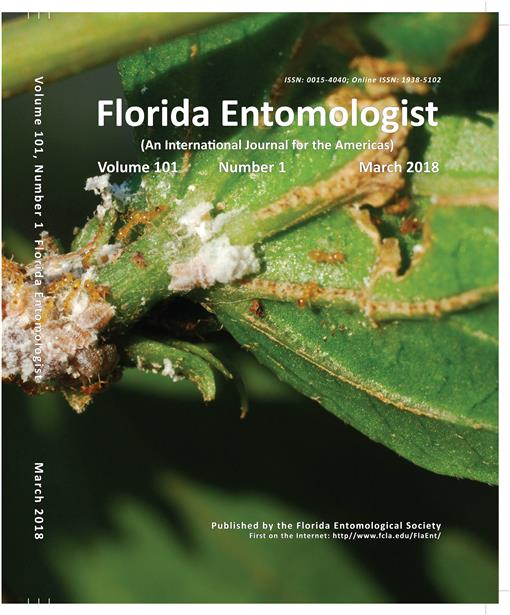Euplatypus parallelus (Coleoptera: Curculionidae) is a neotropical ambrosia beetle that that is rapidly spreading around the world. It has been recorded from over 80 host trees and is implicated as a primary pest attacking rubber trees and rosewood. Here, we report the first country record and successful establishment of the species in Hainan, China. Currently, E. parallelus does not appear to act as a destructive forest pest in Hainan.
Euplatypus parallelus (F.) (Coleoptera: Curculionidae: Platypodinae) is one of the most common ambrosia beetles in Central and South America (Silva et al. 2013). It is polyphagous and is reported to infest over 82 plant tree species from 25 families (Gümüş & Ergün 2015). Although this species is native to the neotropics, it is one of the most invasive of all the Platypodinae. In the late 1800s, E. parallelus was introduced into Africa where it is now fairly widespread, while it is currently spreading rapidly in southeastern Asia (Beaver 1999; Boa & Kirkendall 2004; Gümüş & Ergün 2015).
Most platypodine species infest only freshly dead or dying trees. However, E. parallelus is one of the few species that can successfully colonize live trees, although it is typically associated with trees stressed by drought, disease, or flooding (Boa & Kirkendall 2004). Euplatypus parallelus has been reported to attack live rubber trees (Hevea brasiliensis [Malpighiales]) in Brazil (Silva et al. 2013), implicated in a major die-off of Indian Rosewood (Dalbergia sissoo [Fabales]) in Bangladesh (Boa & Kirkendall 2004), and repeatedly reported as a suspect of transmitting fungal pathogens of trees (Sanderson et al. 1997; Boa & Kirkendall 2004; Bumrungsri et al. 2008; Tarno et al. 2016). For example, in Indonesia, Malaysia, Singapore, and Thailand, E. parallelus has been associated with Fusarium, a causative agent of wilt on Pterocarpus indicus (Sanderson 1997; Bumrungsri et al. 2008; Tarno et al. 2016).
Even though E. parallelus is spreading rapidly in Asia, it has not yet been reported from China where it is considered a regulated pest (General Administration of Quality Supervision, Inspection, and Quarantine of the People's Republic of China 2017). During Oct 2016, many representatives of platypodine ambrosia beetles were captured in light traps (UV blacklight) and hand-collected from dead rubber trees in Danzhou, Hainan (19.4375°N, 109.5585°W; 143 masl). The first specimens were preserved in 100% ethanol and sent to the University of Florida (UF), School of Forest Resources and Conservation, Forest Entomology Laboratory, where they were confirmed as E. parallelus using the taxonomic keys by Atkinson (1989) and Wood (1993). Specimens were deposited in the UF Forest Entomology Laboratory Collection. After the initial collection, 2 additional surveys were carried out in Dec 2016 and from May to Jun 2017. During the collection in 2017, kairomone-baited traps also were used that contained alpha-pinene, beta-pinene, verbenone, and ethanol (Wako Pure Chemical Industries, Japan). In total, 246 specimens of E. parallelus were collected from 10 locations in Hainan, China (Table. 1). Several individuals of other platypodine species (Dinoplatypus cavus and Crossotarsus externedentatus [Coleoptera: Curculionidae]) also were collected from dying trees during the surveys.
Table 1.
Collection of Euplatypus parallelus specimens in Hainan, China, from 2016 to 2017.

A subset of the Hainan samples was submitted to the Jiangxi Agriculture University for molecular identification. Genomic DNA was extracted from 2 individuals from 2 locations in Hainan (Xinglong and Bawangling; Table 1). Portions of the cytochrome oxidase subunit I (COI) and the nuclear ribosomal 28S regions of E. parallelus were amplified using oligonucleotide primers S1718 and A2237 as well as S3690 and A4285, respectively (Jordal et al. 2011). The National Center for Biotechnology Information's Basic Local Alignment Search Tool (BLAST) was used to identify the nucleotide sequences. Cytochrome oxidase subunit I and rDNA sequences (2016113001, 20161205003) were 98% similar to the E. parallelus #PlEup03 and #PlEup04 (GenBank accessions KR261327 and KR261328, respectively). Both 28S rDNA sequences were 99% similar to the E. parallelus #PlEup03 and #PlEup04 (Gen-Bank accessions KR261230 and KR261231, respectively). Previously, E. parallelus #PlEup03 and #PlEup04 have been reported by Jordal (2015) from two populations from Brazil and Cameroon, respectively.
Collection data showed that this beetle has successfully colonized Hainan Island and is now widely distributed there (Fig. 1). Specimens were collected at 10 locations on the island, including natural old-growth forest as well as planted forests, mostly rubber tree plantations. During the last large-scale survey of forest pests in Hainan (15 years ago), E. parallelus was not recorded (Yin et al. 2002), therefore we assume that the species was introduced to the area between 2003 and 2015. It is important to note that our sample data were restricted to Hainan Island. Therefore, we do not know whether this beetle has been introduced into mainland China. Currently, specimens we collected from rubber trees were already dying from other causes. Euplatypus parallelus does not appear to act as a destructive forest pest in Hainan.
Fig 1.
The collections of Euplatypus parallelus (Coleoptera: Curculionidae) in Hainan, China, reported in this paper.

We thank Jia Lv and Shan Tian (Jiangxi Agriculture University, China) for aid in beetle collections. Additional thanks to Thomas H. Atkinson (University of Texas, USA) for training the first author on platypodine identification and to Demian Gómez (University of Florida, USA) for proofreading. This research was supported by grants from the National Key Research and Development Project of China (No. 2017YFC1200600). Authors Y. L. and J. H. were supported by the USDA Forest Service, the USDA APHIS Farm Bill section 100007, and the National Science Foundation.





